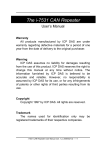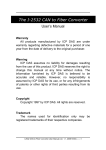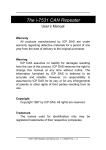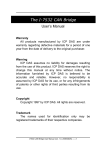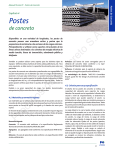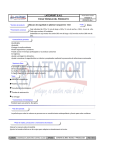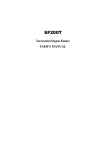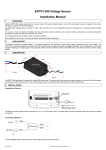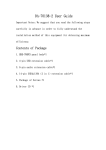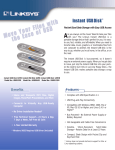Download I-7531 User Manual
Transcript
The I-7531 CAN Repeater User’s Manual Warranty All products manufactured by ICP DAS are under warranty regarding defective materials for a period of one year from the date of delivery to the original purchaser. Warning ICP DAS assumes no liability for damages resulting from the use of this product. ICP DAS reserves the right to change this manual at any time without notice. The information furnished by ICP DAS is believed to be accurate and reliable. However, no responsibility is assumed by ICP DAS for its use, or for any infringements of patents or other rights of third parties resulting from its use. Copyright Copyright 1997 by ICP DAS. All rights are reserved. Trademark The names used for identification only may be registered trademarks of their respective companies. I-7531 CAN Repeater User Manual (ver. 1.5, 2012/11/22) ------1 1 Tables of Content 1 2 3 Tables of Content....................................................................................2 Introduction.............................................................................................3 2.1 Features..........................................................................................4 2.2 Specifications ................................................................................4 2.3 Application .....................................................................................4 Technical data .........................................................................................5 3.1 Block Diagram................................................................................5 3.2 Appearance ....................................................................................6 3.3 3.4 3.5 4 5 Pin Assignment..............................................................................7 Wire Connection ............................................................................9 Status LED....................................................................................10 3.6 Terminator Resistor Setting ........................................................10 3.7 Cable Selection ............................................................................12 3.8 Driving Capability and Baud Rate ..............................................13 Application Architecture ......................................................................15 Dimension and Mounting .....................................................................16 I-7531 CAN Repeater User Manual (ver. 1.5, 2012/11/22) ------2 2 Introduction The I-7531 is a CAN repeater used to establish a physical coupling of two or more segments of a CAN bus system. User can implement tree or star topologies as well as for long drop lines with I-7531. Connecting via I-7531, the division of a CAN system into several subsystems increases the maximum number of bus nodes. Figure1. Application of I-7531 The I-7531 is an optically isolated CAN repeater which provides 2500 Vrms optical isolation allowing you to separate and protect critical segments of the system from the rest of the CAN network. And its galvanic isolation isolates both CAN segments from each other as well as from the power supply. The CAN connection of I-7531 is by terminal blocks. A power supply of 10 ~ 30 VDC is required. The I-7531 is housed in a rugged DIN-Rail mountable box, making it easy to install in an industrial cabinet. Therefore, I-7531 can be used in CANopen, DeviceNet and generic ISO 11898-2 standard. If user wants to know more detail information about the I-7531, please visit our website as follow: http://www.icpdas.com/products/Remote_IO/can_bus/i-7531.htm I-7531 CAN Repeater User Manual (ver. 1.5, 2012/11/22) ------3 2.1 Features z z z z z z z High speed Removable terminal block Mountable on DIN Rail Bus pins protected against transients in an industrial environment No disturbance of the bus lines with an un-powered node Transmit data (TxD) dominant time-out function prevents the output drivers from driving a permanent dominant state A thermal protection circuit is integrated to prevent the transceiver from damage if the junction temperature exceeds thermal shutdown level. 2.2 Specifications z z z z z z z z z z z z z Support CAN 2.0A/CAN 2.0B Fully compatible with ISO 11898-2 Maximum communication baud : 800Kbps Propagation Delay: ~200ns Driving capability: Up to 100 nodes on each CAN port Photo-coupler isolation between 2 CAN ports: 2500 Vrms Power consumption: 2W max CAN terminal resistors are integrated (can be disabled by jumper) 3KV galvanic isolated among of power supply and each CAN port Power Supply: +10VDC ~ +30VDC Operating temperature: -25°C ~ +75°C Humidity: 5% ~ 95% Dimensions: 122 mm x 72 mm x 35 mm 2.3 Application z z z z z z z Factory Automation Building Automation Home Automation Vehicle Automation Control system Monitor system … I-7531 CAN Repeater User Manual (ver. 1.5, 2012/11/22) ------4 3 Technical data 3.1 Block Diagram Figure 2 is a block diagram illustrating the functions of the I-7531 module. Power supply are with 3000 VDC galvanic isolated between each CAN port. Futhermore, there is photo-isolation 2500 Vrms between two CAN ports. CAN Port 1 CAN_H DC DC Physical CAN layer 120 Ohm CAN_L 3000 VDC Isolation 2500 Vrms Photo Isolation 3000 VDC Isolation DC CAN Port 2 CAN_H DC Physical CAN layer 120 Ohm CAN_L Block Diagram of I-7531 +10 VDC ~ +30 VDC Figure2. Block Diagram of I-7531 I-7531 CAN Repeater User Manual (ver. 1.5, 2012/11/22) ------5 3.2 Appearance Frame Ground Status LED of Power FG GND (CAN) 11 CAN_H 20 CAN_L CAN Port 2 i-7531 & Communication CAN bus Repeater ‧Support CAN 2.0A/2.0B ‧Photo-isolation: 2500 Vrms ‧Expand the number of CAN buses ‧Mountable on DIN Rail CAN Port 1 (B)GND 10 (R)VS+ FG GND (CAN) CAN_H CAN_L 1 3000V Isolation Power Input Frame Ground Figure3. Apperance of I-7531 I-7531 CAN Repeater User Manual (ver. 1.5, 2012/11/22) ------6 3.3 Pin Assignment CAN_L 1 20 CAN_L CAN_H (CAN) (CAN) GND CAN_H FG GND FG (R)VS+ (B)GND10 11 Figure4. Pin Aassignment of I-7531 Table1. Pin Description of I-7531 No. Part Name 1 Description CAN_L CAN_Low. Signal Line of CAN port 1. CAN_H CAN_High. Signal Line of CAN port 1. 5 CAN Port 1 7 FG FG 9 (R)VS+ 10 Power Input 14 FG 3 16 18 20 GND Frame Groud. Voltage Source. It could be +10VDC ~ +30VDC. (B)GND Power Ground. FG CAN Port 2 CAN_Ground (or CAN_GND), Voltage level of ground of CAN_L and CAN_H of CAN port 1. GND Frame Groud. CAN_Ground (or CAN_GND), Voltage level of ground of CAN_L and CAN_H of CAN port 2. CAN_H CAN_High. Signal Line of CAN port 2. CAN_L CAN_Low. Signal Line of CAN port 2. I-7531 CAN Repeater User Manual (ver. 1.5, 2012/11/22) ------7 Note 1: In some cases, the voltage level of CAN_GND of different CAN device in the same CAN bus system are not equal. At this time, it could cause some problems to derogate system staibility of this CAN bus system. There is one way to relieve this situation; user can connect the CAN_GND between those CAN devices to achieve equal voltage level of CAN_GND. Wiring of CAN_GND is not necessary; user can modify the configuration of wiring according to actual applications. Note 2: Electronic circuits are constantly vulnerable to Electro-Static Discharge (ESD), which become worse in a continental climate area. FG(Frame Ground) provides a path for bypassing ESD to earth ground, allowing enhanced static protection (ESD) capability and ensures that the module is more reliable. If user wants to use FG, both the Pin 7 and Pin 14 should be connected to earth ground. Within the I-7531, Pin 7 and Pin 14 (FG) are not interconneced. I-7531 CAN Repeater User Manual (ver. 1.5, 2012/11/22) ------8 3.4 Wire Connection CAN Port 2 CAN_GND Earth Ground CAN_H CAN DEVICE CAN_L 5 1 9 6 CAN Port 1 Power CAN_L Power GND CAN_H CAN_GND +10VDC ~ +30VDC Earth Ground Figure5. Wire Connection of I-7531 I-7531 CAN Repeater User Manual (ver. 1.5, 2012/11/22) ------9 3.5 Status LED When user turning the I-7531 on, the status LED of I-7531 will be display with red light. Moreover, when a message passes through I-7531, the status LED will be twinkle once with yellow light while the red light is still on. Note 3: Twinkling rate correlates with baud rate of CAN bus. User may see no twinkling when the twinkling period is too short because of the higher baud rate of CAN bus. Besides, the yellow LED could look like always on when bus loading is heavy. 3.6 Terminator Resistor Setting According to the ISO 11898-2 specifications, the bus line of CAN_H and CAN_L must be terminated by resistor for proper operation. The equivalent resistance between CAN_H and CAN_L should be 60Ω. There are some examples below. Case1: RT = 120Ω Case2: RT = 180Ω CAN_H RT CAN_H RT RT RT CAN_L CAN_L RT Case3: RT1 = 180Ω, RT2 = 120Ω CAN_H RT1 RT1 RT2 CAN_L RT1 Figure6. Terminator Resistor I-7531 CAN Repeater User Manual (ver. 1.5, 2012/11/22) ------10 RT2 On the other hand, the I-7531 module include two build-in 120Ω terminator resistors, user can decide to enable those two terminator resistors or not. The JP2 of I-7531 is used for adjusting terminal resistor on CAN Port 1, and the JP3 of I-7531 is used for adjusting terminal resistor on CAN Port 2. Before adjusting JP2 or JP3 of I-7531, user needs to open the cover of I-7531 first. Those locations of JP2 and JP3 are shown as following: JP2 JP3 CON1 CON2 Figure7. JP2 and JP3 positions The following connection statuses present the condition if the terminal resistor is enabled (default) or disabled. Disable (Deactivate) Enable (Activate) Figure8. Adjustment of Terminator Resistor I-7531 CAN Repeater User Manual (ver. 1.5, 2012/11/22) ------11 3.7 Cable Selection The CAN bus is a balanced (differential) 2-wire interface running over either a Shielded Twisted Pair (STP), Un-shielded Twisted Pair (UTP), or Ribbon cable. The table below show recommended DC parameters of CAN bus line. Table2. Recommended DC parameters for CAN Bus Line Wire Cross-Section [mm2] Resistance [Ω/km] ~0.25 (AWG23) < 90 ~0.5 (AWG20) < 50 ~0.8 (AWG18) < 33 ~1.3 (AWG16) < 20 The recommended AC parameters of CAN bus line are 120Ω impedance and 5 ns/m specific line delay. I-7531 CAN Repeater User Manual (ver. 1.5, 2012/11/22) ------12 3.8 Driving Capability and Baud Rate The relationship between ideal total bus length and baud are displayed below. Table3. Baud, Total Bus Length, and Number of I-7531 Baud [bit/sec] Ideal Bus Length without I-7531 [m] Max I-7531 Number 800K 50 1 500K 100 2 250K 250 6 125K 500 12 50K 1000 25 20K 2500 62 10K 5000 125 Note 4: When users add one I-7531 into a CAN network, the ideal total bus length will reduce 40 meters because of the propagation delay of I-7531. For example, if users use baud 500K and one I-7531, the ideal total bus length will be “100 – 40 * 1 = 60 meters“. After deciding the number of I-7531 and calculating the corresponding ideal bus length, users can use the following table to know the maximum node number in each segment and the maximum segment length when using different type of wire. Table4. Driving Capability Wire CrossSection [mm2] The maximum segment length [m] under the case of specific node number in this segment 16 Nodes 32 Nodes 64 Nodes 100 Nodes ~0.25 (AWG23) <220 m <200 m <170 m <150 m ~0.5 (AWG20) <390 m <360 m <310 m <270 m ~0.8 (AWG18) <590 m <550 m <470 m <410 m ~1.3 (AWG16) <980 m <900 m <780 m <670 m I-7531 CAN Repeater User Manual (ver. 1.5, 2012/11/22) ------13 Note 5: The definition of segment and the relationship between segment length (Lseg1, Lseg2 …) and ideal total bus length (Ltotal) are shown in the following figure. Segment 1 I-7531 Segment 2 I-7531 Segment 3 L2a L1 L3 L2b Lseg1 Lseg2 Lseg3 Lseg4 Ltotal = = = = = L1 L2a + L2b L3 L4 Lseg1 + Lseg2 + Lseg3 + Lseg4 I-7531 Segment 4 L4 Figure9. Definition of Lseg1 and Ltotal I-7531 CAN Repeater User Manual (ver. 1.5, 2012/11/22) ------14 4 Application Architecture Figure10. Application Architecture I-7531 CAN Repeater User Manual (ver. 1.5, 2012/11/22) ------15 5 Dimension and Mounting Figure11. Dimension I-7531 CAN Repeater User Manual (ver. 1.5, 2012/11/22) ------16 Figure12. Assembly Drawing Figure13. Mounting I-7531 CAN Repeater User Manual (ver. 1.5, 2012/11/22) ------17

















